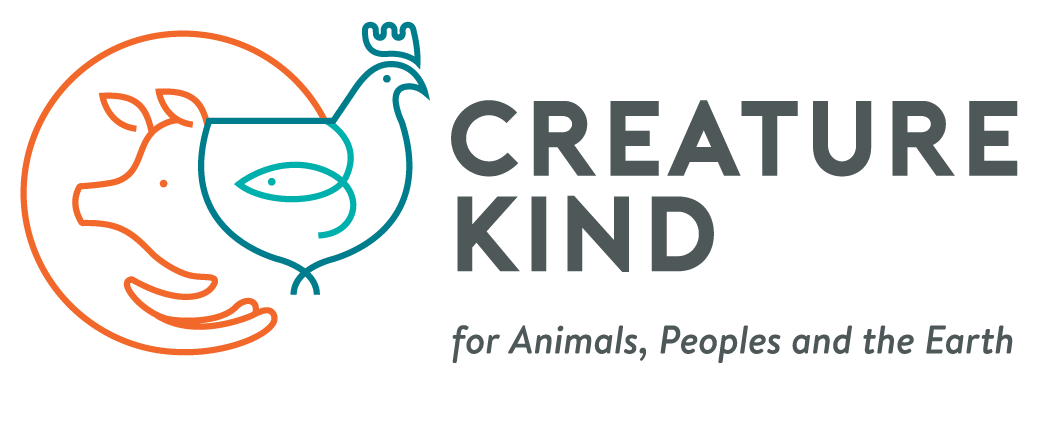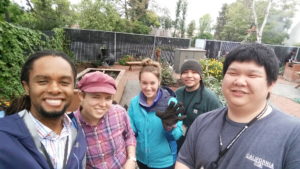Interspiritual Friendships and the Care of Animals
by Michael J. Iafrate
A few months ago, I sat in a crowded movie theatre watching the local premiere of the documentary Hare Krishna! The Mantra, the Movement and the Swami Who Started It All. The majority of the audience was made up of members of a nearby West Virginia Hare Krishna community called New Vrindaban founded in 1968. The film tells the story of A. C. Bhaktivedanta Swami Prabhupada’s journey from India to the United States, virtually penniless, in 1965, his founding of the International Society for Krishna Consciousness (ISKCON), and the explosion of his spiritual movement. Many of the devotees around me knew Prabhupada personally and have been connected with New Vrindaban since nearly the beginning.
Michael and Ed Sloane with a friend after Wild Church service | photo by Matt Smith
There was a certain surreal quality in the event, as I felt both like a guest among adherents of a religious tradition very unlike my own, but also like an “insider” among friends. Though I am Roman Catholic, the story of the “Hare Krishnas” is well known to me, having met devotees through the punk rock scene while I was in high school in the early 1990s. Sitting among the devotees, I smiled at the film’s vibrant presentation of the history and its impressive collection of archival footage. I laughed out loud with the rest of the audience at its inside jokes and nodded at its articulation of a contemporary spiritual figure’s ancient wisdom.
Like the devotees, too, I knew the film glossed over some of the more troubling aspects of Prabhupada’s views. But the evening was an appropriate celebration of a religious community with a remarkable history, particularly in this part of the country. And as the film concluded with some of the ways the Hare Krishna movement has touched national and global cultures, the event was an opportunity to pause and be thankful for perhaps the most important gift the Hare Krishnas gave me—a gradual deepening of awareness about the sacredness of creation, and particularly of other-than-human animals.
Wild Church altar | photo by Michael Iafrate
As a teenager, several of my friends had “gone veg” for a variety of reasons: animal rights, environmental, health, political, and so on. And so the conversations among us began. Krishna devotees I knew, though, situated all of these very good arguments for vegetarianism within a wider spiritual context that I, as a fairly typical young Catholic omnivore, found intriguing—and eventually very challenging to my own worldview and lifestyle as I entered adulthood. Though it would take a few more years, after college I realized that through these encounters I had come to internalize an evolving commitment to nonviolence, to seeing creation as sacred, and to understanding eating as a religious act—or better, a sacred or sacramental act. I have been vegetarian, and sometimes vegan, ever since. And when people ask about my reasoning—whether it is for animals rights, environmental, health, or religious reasons—I simply say all of the above.
Becoming a Catholic vegetarian at that point in my life, and before I entered into graduate theological programs and various forms of church and activist work, helped me to enter a path of discovery of resources within my own faith community that witness to a neglected but important tradition of concern for animals, one that is now, thankfully, becoming more well-known and widespread. In the twenty years since I’ve embraced vegetarianism, I have watched the development of deeper reflection on animals among Catholics: a richer appreciation for the care of animals from our tradition’s past, as well as creative expressions of “animal theology” among Catholic theologians, often deeply connected with wider social justice and “life” issues and with more recent eco-theologies as well. This recent reflection has even arguably “trickled up” into “official” church teaching, as concern for animals is seen in the Catholic Catechism and in the teaching of Pope Benedict, and most recently as Pope Francis affirmed the intrinsic worth of animals in his encyclical Laudato Si’.
The gifts I received from these early interspiritual friendships did not end with my own vegetarianism, however. Often, when Christians open themselves to encounter with other faith traditions and learn what they teach about vegetarianism or meditation, they realize that their own traditions contain lesser-known ideas and practices along these lines as well. And they are then content to return to a Christian context which now “meets their needs,” thankful to non-Christians for bringing to their attention aspects of Christian tradition they had not previously seen. While these kinds of revelations are certainly worthy of celebration, I have come to appreciate a more relational and dynamic approach to interspiritual friendships.
Since returning to the Ohio Valley after a time away, I have been blessed with continuing and deepening (and multiplying!) interspiritual friendships with people of many faiths, including members of the New Vrindaban community. Together, in both informal and formal ways, we have initiated a number of local practices of interspiritual friendship, not only to “take” from one another, or to become more aware of obscured aspects of our own traditions, as valuable as these might be, but to nurture real friendships; to share experiences of common worship and contemplation; to enter together into that Holy Mystery within, between, and beyond the words of our particular traditions; and to work together as people of many faiths to create a better world.
One of the ways we have done this is through a small interspiritual community we are calling Wild Church West Virginia. My friend and colleague Ed Sloane and I had heard of the outdoor Eucharistic liturgies of the ecumenical Wild Church Network and Watershed Discipleship movement, and thought it would be appropriate to explore the possibility of a Wild Church community here in West Virginia, bringing to it the uniqueness of the place where we are rooted. From our Catholic context, it seemed especially fitting given our own involvement in the Catholic Committee of Appalachia (CCA) and the Roman Catholic Church’s ecological turn under the leadership of Pope Francis.
Inspired by CCA’s place-based liberation theology, Francis’ theological vision of global eco-justice, and the Wild Church Network’s various expressions of deep ecological liturgy—and deeply moved by the interspiritual experimentation of Bede Griffith’s Saccidananda Ashram (Shantivanam) and the monthly Yeshu Satsang in Toronto—Wild Church West Virginia was born on Pentecost Sunday 2017. Our current mission statement reads:
Wild Church West Virginia is an experiment in “re-wilding our faith.” We believe that many people of faith and good will seek a connection with God and one another that is not limited by institutional walls. Loving encounter grounds and nurtures tradition. By stepping outside and going to the margins we can more readily encounter the mystery of God.
Our monthly outdoor agape meal liturgies witness both to the goodness and brokenness of creation. We have gathered in the hilly, wooded terrain of land connected to Bethany College in West Virginia and in the breathtaking natural “cathedral” of Raven Rocks in Southeast Ohio. Yet we also plan to gather at ecologically damaged places—mountaintop removal sites and street corners which represent to us the destructive social environments humans have constructed and which cry out for justice.
As the community grew, we saw that many people attracted to Wild Church West Virginia were from non-Christian faith traditions, or people alienated from various Christian churches, or people who, like us, share a deep curiosity about “other” faiths and believe that we can and should celebrate with and learn from one another. Though rooted in the Catholic tradition, we soon, very consciously, made more of an effort to become a wildly inclusive, interspiritual community that acknowledges the holiness of the many names of the Divine and welcomes people of all religious traditions to the table.
For our December Wild Church liturgy on the second Sunday of Advent, we worked with a number of devotee friends to hold an Advent/Christmas celebration at New Vrindaban’s goshala (cow shelter), part of their cow protection program. Gathering in the chilly barn among the community’s cows, the interspiritual and multispecies liturgy celebrated Christ coming into the world among people of many faiths and among other-than-human animals, blending Hindu and Christian chants and hymns accompanied by harmonium and guitar (including “The Friendly Beasts”) and readings from Vedic, Hebrew, and Christian scriptures. Ed gave a rich homily on the readings, stressing the unique ability that animals have to teach humans about the Divine and reminding us how fitting it is that animals and their caretakers were the first to welcome the coming of the Light of the World. The lay-led agape meal’s offertory included a Hindu arati service led by a devotee (including the waving of lights before the altar and icons), and we blessed and shared locally made bread and apple juice made from local apples—no wine, as devotees abstain from alcohol. The liturgy was followed by a short kirtan with communal chants to Krishna under the name Gopala (“protector of the cows”) and a sharing of prasadam, a vegetarian sanctified meal, in this case paneer over spinach rice.
Arati service | photo by Jocelyn Carlson
In our Wild Church liturgies, silent interfaith meditation gatherings, and sacred conversations, the friendships begun in our local interspiritual community continue to deepen, and we dream together of new possibilities around the arts and in activism. Together, we are coming to believe in a vision similar to that of Sufi mystic, scholar, and author Llewellyn Vaughan-Lee, that we are called “to return to our own root and rootedness: our relationship to the sacred within creation.” With Vaughan-Lee, we believe that “Only from the place of sacred wholeness and reverence can we begin the work of healing, of bringing the world back into balance.”
That work of healing and of bringing creation back into balance, we believe, must include all of us, learning across traditions. It must also come to include all beings, and indeed may even be led in many ways by those beings long considered to be less than human. Here in West Virginia, a place deeply damaged by the so-called First World’s extractive mentality, we continue to “rewild our faith,” and to learn from the friendly beasts and from their caretakers, including those whose spiritual traditions have been most attuned to non-human animal lives.
Michael J. Iafrate is a theologian and songwriter from West Virginia and a doctoral candidate at the University of St. Michael's College, University of Toronto. He currently serves as Co-Coordinator of the Catholic Committee of Appalachia (CCA) and was the lead author of CCA’s “People's Pastoral” letter The Telling Takes Us Home: Taking Our Place in the Stories that Shape Us. His writing has appeared in National Catholic Reporter and Religion Dispatches, various journals, and the collections Secular Music and Sacred Theology (2013) and Music, Theology, and Justice (2017). He is also a singer-songwriter and old time musician, and his most recent album, Christian Burial, was released in 2017.
















